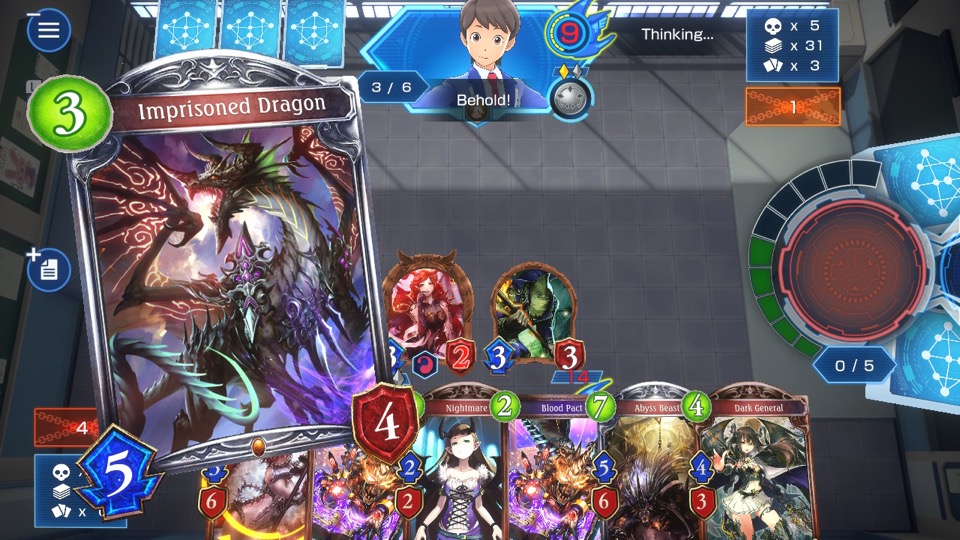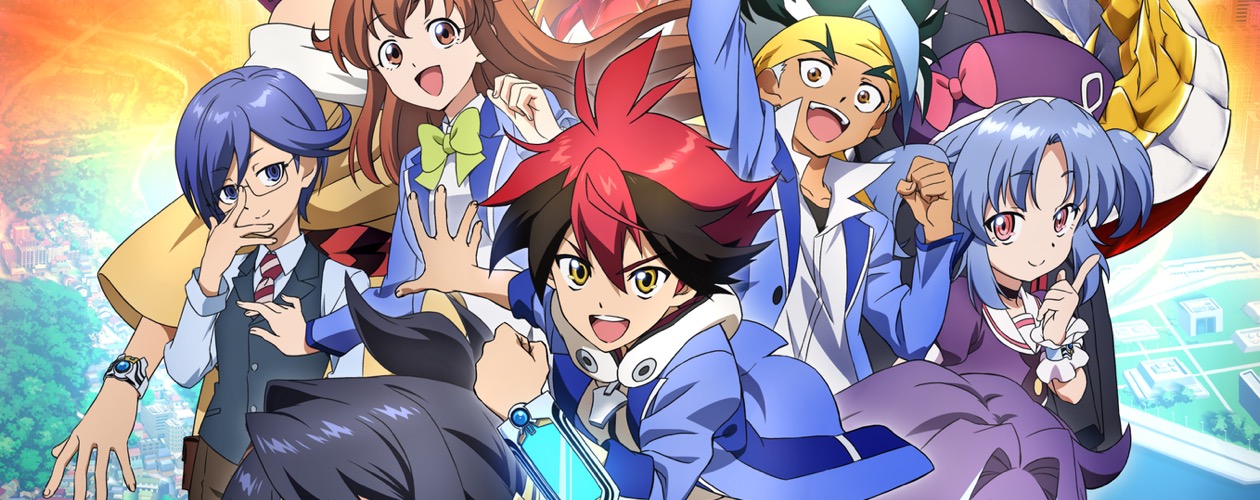Some things just go together — peanut butter and chocolate, French fries and milkshakes, video games and anime. Shadowverse falls firmly into that last category, combining your traditional Japanese school-kid vibes with all of the anime sections (and tropes) that we’ve come to expect from the genre. It does this so reliably, that it will come as little surprise that the latest instalment, Shadowverse: Champion’s Battle, is an RPG deckbuilder based on the 2020 anime, based on the game.
The franchise started out back in 2012 as a CCG by another name, Rage of Bahamut. Assets were upcycled into this new franchise, which has taken off and grown a name for itself. Champion’s Battle, which was released in Japan last November, and is coming to the Switch on 13 August 2021, is already setting itself up for a decent level of success.
I’ve played around 15 hours of the game and for me, so far, Shadowverse is a weird mix of nostalgia and projectile vomiting everything Nihon you could possibly imagine over a surprisingly robust card game of the same name.
How it feels
On one hand, you have the gameplay of Hearthstone (minus the randomness), the vibes of Digimon and Yu-Gi-Oh, and the atmosphere of Persona crossed with Final Fantasy VIII. Imagine if Squall put down his gunblade and took a term to run around Balamb Garden, becoming the national Triple Triad champion. That’s what this game feels like, and I’ve long been on the record saying I would pay good money for that game.
Square Enix, seriously, I would pay good money for that game.
But on the other hand, you have the art. Don’t get me wrong — the art in Shadowverse is gorgeous. The anime cutscenes are gorgeous, if 100% trope-a-dope storytelling, checking every box on its way out of the nostalgia factory. The battlefield is also pretty well designed, and with a little practice, you’ll quickly be able to read the tide of battle at a glance. No problems there.
The issue is with the cards in this card game. There are more than 600 cards in this game to collect, which is excellent — that’s around two full Magic the Gathering sets, which is a lot of cards. And yet, why do the vast majority of them look the same? The pictures of dragons are cool. The pictures of liches are beautifully drawn. Even the zombies look all zomb-y. But why do the vast majority of the cards involve a buxom woman showing off her digital assets? Why, of god why, are there sexy nuns? We’ve been through this, games industry, and we do not want the sexy nuns. Stop it.

The card Imp Lancer is a grand example of this, and 100% feels like it’s NSFW. If I was 14 and my mom walked in on me playing that on the Switch while docked, I think she’d start making assumptions about me and how I view women very quickly.
The flip side to this is that for all of the effort that went into the art — and don’t get me wrong, the art is very well drawn — the game totally fails at celebrating CCGs. The cards are pure MTG Arena/Hearthstone tiles, with no rules text or flavour text. That’s all there for you in the submenus, but nowhere to be seen when you want to just view the card.
Speaking of which, part of the fun of this genre is being able to pick up the sweet card your opponent plays and examine the fancy new piece of cardboard tech. You can’t do this in Shadowverse — you can’t even zoom in on the card/art, which is a little puzzling when it otherwise feels like it’s jamming boobs and butts in my face at every opportunity other than when you actually want to view the cards.

How it plays
Now that we’ve covered that, let’s look at the actual game part of the game. You’re a transfer student thrown into life at a new school in a world obsessed with this game you’ve never heard of. If you’ve played any game/seen any anime, you know the shtick. Your mission is to learn the ropes, resurrect your failing card game club and become the national champion. So far, so normal. The beauty of the game is that the card game is actually pretty well developed. From here on out, we’re looking under the bonnet, as it were.
There are eight Classes (archetypes) which you pick between, each of which feels pretty well balanced at this point:
- Forestcraft (Elf Tribal)
- Swordcraft (White Weenies)
- Runecraft (Mono-blue)
- Dragoncraft (Dragon Ramp)
- Shadow craft (Mono-black)
- Bloodcraft (Rakdos)
- Havencraft (Mono White)
Each has their own keyword ability the game tracks for you. Runecraft, for example, specialises in ‘Spellboost’ (a game-long Prowess-style cost reduction mechanic) cards which are strengthened with every spell you play. Shadowcraft, firmly in the mono-black camp, uses the Necromancy skill to harvest ‘Shadows’ (the souls of the dead), which it uses as a resource to cast other spells/trigger ETB effects.

Each also has variations on the theme, as you’d expect if you’ve played CCGs competitively, and can split pretty clearly into control, midrange or aggro — the game actually does this for you on the deck-selection screen, which is more user-friendly than I’m used to. As an example, Havencraft, could lean into Angel tribal or it could equally be what we call a ‘butt damage’ deck, based on Followers that attack using their high defence stats. With so many cards to choose from, there are genuine options here.
Making a deck with that many cards can be daunting though. Fortunately, winning a match against an opponent unlocks a couple of things: XP for your class (which level up independently), rupees (for buying cards, booster packs, sleeves and profile emblems), and ‘deck codes’. This is a pretty good mechanic — the deck code unlocks the precon list of the deck you just beat, meaning that you can instantly create the deck at any later date. If you’re missing the cards, you either pin them for purchase next time you see a vendor, or you can edit the deck to replace them with cards you do have.
Mechanically, it’s similar to what you’re used to with games like Magic, but with different names. Lifelink has become Bane; Haste has become Storm — which is a little confusing if you’re a Magic player, but you’ll get used to it. The real difference is the Evolve mechanic — each of the Followers (creatures) you cast can evolve into a powered-up version of itself. But with limited activations per game (two or three depending on who went first), the timing and execution of this will very much decide the turn of battle.
For those who haven’t got a clue, there is a handy ‘Hint’ system, which tells you which play you should be making, but don’t rely on too heavily after your first few hours. I quickly found it steering me wrong, missing lethal on several occasions. Last but not least, there are a few things that the game could explain better. Why do some players have a lower starting life? Like Magic, you both start at 20 and you win when your opponent gets to 0, but why do I often play against people with 15 life?
Also, there’s a quirk with Evolve, in that it gives followers pseudo-haste. The game says they can attack the turn they evolve, but that’s not strictly true — if they entered the battlefield that turn, they can almost always attack enemy followers that turn, but not always and they can’t attack the opponent directly unless they’ve been on the battlefield for a full turn-cycle.

Parting thoughts
Shadowverse is an intriguing and enticing game, and I’m thoroughly enjoying it. It plays like a Persona game and sounds like Balamb Garden. It’s full of cutesy themes and amusing memes, but the Japan is turned up to jyi-ichi and it can be a little much, even for me — and I’m a fully paid-up member of the gaijin card club — putting it firmly in the camp of ‘Weeb bait’. Does that mean I’m going to stop playing it? Hell no, but will all it all get a bit too much by the end? That remains to be seen.

